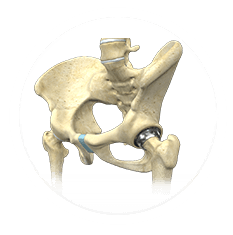Hip Injuries
The hip is a ball and socket joint made up of the femoral head (ball), acetabulum (socket), and articular (joint) cartilage. A ring of cartilage, called the labrum, lines the inside of the socket and is responsible for many important functions of the hip. Though the hip is designed to withstand a great deal of stress, hip injuries are common. When there are problems with the ball, the socket, or any component of the cartilage or soft tissue that surrounds the hip, pain, weakness, and restricted mobility may occur.
These, and various other problems of the hip joint, can be treated with minimally invasive hip surgery. Some examples of common hip conditions include:
- Articular cartilage injury: Injury to the cartilage that lines the ends of the bones in the hip joint
- Heterotopic ossification: Excess bone growth near or around the hip joint
- Labral tear: Tear of the labrum, a piece of cartilage which lines the hip socket
- Loose bodies: Fragments of bone or cartilage within or near the hip joint
- Hip impingement: Abnormal bone growth that may cause pain or interfere with the function of the hip
- Tendon tears: Tears of the tendons surrounding the hip joint
- Bursitis: Inflammation of the bursa, a fluid filled sac that cushion the outside of a bone.
Common symptoms of hip problems include:
- Pain
- Swelling
- Reduction in range of motion
- Catching or popping
- Weakness
- Instability or "giving way" of the joint
When you present to the clinic with a hip injury, you will be asked about your general health status and any prior injuries or diseases. An in depth examination of your hip and evaluation of your symptoms will be completed.
Imaging tests are commonly ordered to help evaluate the hip problem and aid in correct diagnosis. These may include:
- X-rays: X-rays may indicate abnormal shapes of the hip bones. X-rays also help detect the presence of arthritis.
- Computed tomography (CT): CT scans help provide more information about the structure of your hips and pelvis.
- Magnetic resonance imaging (MRI): MRI scans can detect damage to the cartilage or labrum of the hip. A dye may be injected during the exam to make the MRI scan more precise.
These tests help in diagnosing the hip problem and also help your doctor decide the most effective treatment plan for you.
Treatment of hip disorders can vary widely depending upon the type of injury. Typically conservative measures are recommended first. This usually includes: rest, ice, medication, and physical therapy. In some instances, an injection into or around the joint may be indicated.
Arthroscopic hip surgery is commonly recommended to treat labral tears, injuries to the articular cartilage, hip impingement and loose bodies.
Minimally invasive hip replacement surgery is often recommended in patients with osteoarthritis or AVN of the hip.




